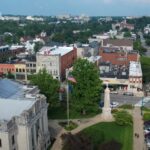Long before Indiana became a state, its lands were home to thriving Indigenous nations. From the intricate mound complexes of the Mississippian culture at Angel Mounds to the enduring legacies of the Miami, Potawatomi, Shawnee, and Delaware (Lenape) peoples, Indiana’s landscape tells a story of rich Native traditions, resilience, and survival.
The Angel Mounds site near Evansville, for example, stands as a testament to a complex society that existed centuries before European contact, showcasing advanced agricultural practices and intricate social structures. This article explores the rich tapestry of Native American history in Indiana, covering land, culture, and legacy.
Indigenous Nations of Indiana
Miami (Myaamia)

The Miami people, part of the Algonquian language family, lived across northeastern Indiana, western Ohio, and parts of Illinois. Their name, “Myaamia,” translates to “downstream people,” signifying their historical ties to river systems like the Wabash and Maumee Rivers.
The Miami were highly skilled in agriculture, cultivating maize, beans, and squash, and were also adept hunters and fishers. Their social structure was organized around extended families (clans) and leadership councils, with Kekionga (present-day Fort Wayne) as a central hub of trade and diplomacy.
Miami artisans crafted tools and decorative items from shell, bone, and copper, and their villages included longhouses made from wood and bark. They played significant roles in regional diplomacy, negotiating with both European powers and neighboring nations.
Potawatomi (Bodéwadmi)
The Potawatomi, part of the larger Anishinaabe confederacy, inhabited northern Indiana and parts of Michigan, Wisconsin, and Illinois. Their name means “keepers of the fire,” referring to their role in maintaining the sacred fire of the council shared with the Ojibwe and Odawa.
The Potawatomi lived in wigwams—large, dome-shaped structures made of wooden frames and covered with mats or bark. Their diet combined agriculture (corn, beans, squash) with hunting of deer and small game, plus fishing and gathering of wild plants.
Potawatomi communities were tightly knit, with decisions made by councils of elders and leaders.
They were involved in several key resistance movements against U.S. expansion, including during the War of 1812. Many were forcibly removed during the Trail of Death in 1838, but some, including members of the Pokagon Band, remained in the region.
Shawnee
The Shawnee were known for their adaptability and resilience, living in southern Indiana along river corridors. Originally from the Ohio Valley, they moved into Indiana after conflicts with European settlers.
The Shawnee were semi-nomadic, establishing temporary villages and moving with seasonal hunting and gathering patterns. They built wigwams and longhouses, and their political structure was highly organized, with a division of leadership between war chiefs and civil chiefs.
The Shawnee language, part of the Algonquian family, preserved rich oral traditions and ceremonial practices. Leaders like Tecumseh and Tenskwatawa (the Prophet) formed a pan-Indigenous confederacy in the early 19th century, centered at Prophetstown near Lafayette.
Their resistance was a direct response to aggressive U.S. settlement policies, culminating in the Battle of Tippecanoe (1811).
Delaware (Lenape)
The Delaware (Lenape) originally inhabited the Mid-Atlantic regions of present-day New Jersey, Delaware, and eastern Pennsylvania. After being displaced by European colonization and military pressures, they moved westward into Ohio and Indiana by the late 1700s.
In Indiana, the Lenape settled along the White River in central parts of the state, creating villages that reflected their strong social and political organization. They constructed longhouses, practiced agriculture, and maintained clan-based governance.
The Lenape were known for their council fires, where decisions were made collectively, and for their rich oral traditions that preserved laws, history, and stories. In Indiana, the Delaware were active in trade networks and maintained relations with the Miami and other nations.
However, they faced displacement again due to treaties like the Treaty of St. Mary’s (1818), which ceded large portions of central Indiana to the U.S. government.
Cultural and Spiritual Traditions

Agriculture and Trade
Indiana’s Native peoples developed highly efficient agricultural systems, focusing on the cultivation of the Three Sisters—maize (corn), beans, and squash. These crops were interplanted, with maize providing a structure for beans to climb and squash acting as a natural ground cover to retain moisture and deter pests.
This method not only maximized productivity but also enriched the soil. In addition to cultivated crops, Native communities gathered wild plants such as nuts, berries, and medicinal herbs.
Hunting provided a steady supply of deer, turkey, and small game, while fishing in Indiana’s rivers and lakes added variety to their diets.
The extensive trade networks of Indiana’s Native nations connected them with tribes across the Great Lakes, the Ohio Valley, and beyond. Archaeological finds at sites like Angel Mounds show evidence of long-distance trade: marine shells from the Gulf of Mexico, copper from the Upper Great Lakes, and chert (flint) from quarries in Illinois and Ohio.
These networks enabled not just the exchange of goods but also the transmission of ideas, artistic styles, and ceremonial practices.
Art and Language
Indiana’s Native nations were skilled artisans, producing beadwork, pottery, woven mats, carved wooden objects, and shell and bone jewelry. Designs often carried symbolic meanings connected to clan affiliations, natural cycles, and spiritual beliefs.
Potawatomi artists, for instance, created intricately beaded bags and bandolier pouches with floral and geometric motifs, while Miami artisans crafted woven belts and baskets for both everyday use and ceremonial purposes.
The dominant languages in the region were from the Algonquian family, including Miami-Illinois, Potawatomi, Shawnee, and Delaware dialects. These languages were rich in metaphor and deeply intertwined with oral storytelling traditions.
Storytellers preserved histories, moral lessons, and clan laws, passing them down through generations. Songs and chants were also integral to daily life and ceremonies, serving both practical and spiritual functions.
Spiritual Beliefs
View this post on Instagram
Spirituality was inseparable from daily life for Indiana’s Native peoples. Their beliefs were rooted in a deep respect for the land, animals, ancestors, and natural forces.
Many communities believed that spirits, often referred to as manitous (in Algonquian languages), inhabited all aspects of the natural world. These spirits could influence hunting success, crop fertility, and community well-being.
Ceremonies marked key moments in the agricultural and seasonal calendar, including spring planting rituals, harvest festivals, and midwinter feasts. Mourning practices honored the deceased and guided their spirits to the afterlife, with burials accompanied by grave goods like tools and ornaments.
Sacred sites held particular significance. Angel Mounds, a Mississippian-period site near modern-day Evansville, was a ceremonial and political center with platform mounds likely used for elite residences and ritual gatherings.
Rivers like the Wabash and White Rivers were also revered, with certain stretches designated for offerings and prayer. Groves of ancient trees and natural rock formations served as meeting places for councils and spiritual reflection.
Spiritual leadership was provided by elders, shamans, or medicine people, who interpreted dreams, conducted healing rituals, and maintained knowledge of ceremonial protocols. These leaders guided the community in times of crisis, marking transitions from birth to adulthood and from life to death.
Land Displacement and Treaties
Key Treaties
Indiana’s Native lands were ceded through a series of treaties, often under pressure or deceit. Major agreements included:
Treaty
Year
Key Points
Treaty of Fort Wayne
1809
Ceded over 3 million acres, sparking resistance by Tecumseh
Treaty of St. Mary’s
1818
Led to the removal of Miami and Delaware from central Indiana
Treaty of Chicago
1833
Forced cessions of northern Indiana lands by Potawatomi
Forced Removals
Forced to march from Indiana, the Potawatomi tribe arrived at present-day Osawatomie, KS November 4, 1838. Dozens died along the way. Today, the Potawatomi Trail of Death has been declared a Regional Historic Trail. Read about the Potawatomi Trail of Death https://t.co/iLewRBeKps pic.twitter.com/EqLfn3j35K
— American History (@legendsamerica) November 4, 2024
The Potawatomi Trail of Death (1838) saw the forced march of over 850 Potawatomi from Indiana to Kansas. Nearly 40 people died along the route. Other groups, including the Miami and Delaware, faced similar pressures, with many relocated to reservations in present-day Oklahoma and Kansas.
Resistance and Resilience
Tecumseh’s Confederacy
Tecumseh, a Shawnee leader, sought to unite Native nations against U.S. expansion. His confederacy was centered at Prophetstown, near present-day Lafayette. Despite defeats at Tippecanoe (1811) and later during the War of 1812, Tecumseh’s vision of Indigenous unity inspired generations.
Cultural Survival
Despite forced removals, many Native people remained in Indiana or returned. They maintained language, ceremonies, and community bonds. Families continued to pass down traditions, and some reestablished themselves on ancestral lands.
Modern Presence and Cultural Revitalization

Active Communities
Today, Native Americans in Indiana include descendants of the Miami Nation of Indiana, Pokagon Band of Potawatomi, Delaware Tribe of Indians, and others. While not all are federally recognized, they maintain active cultural and advocacy organizations.
Revitalization Efforts
Initiatives include language revitalization programs, powwows, and educational outreach. Cultural centers, such as the Eiteljorg Museum of American Indians and Western Art in Indianapolis, showcase Native art and history. Modern efforts like the Land Back movement highlight the push to restore Indigenous stewardship of ancestral lands.
Legacy and Learning
Indiana’s public memory reflects Native legacies through place names (e.g., Wabash, Tippecanoe, Kankakee) and historical markers. However, many residents know little about the depth of Indigenous history. Schools are increasingly incorporating Native history into curricula, but challenges remain in presenting accurate, respectful narratives.
Museums, cultural centers, and tribal-led programs are crucial for preserving and teaching this legacy. Visitors to sites like Angel Mounds can engage with the physical remnants of ancient cultures, while educational materials highlight the living traditions that continue today.
Conclusion
@nativeamericancultures I found myself in the desert amongst friends. Honor our natives! #nativeamerican #nativeamericanmusic #powwowtrail #cree #nativepride #nativepeople #sioux #indigenous #navajo #FirstNations #powwow #jingledress #culture #suite #dancing #viral #foryou #fpy ♬ nhạc nền – Native Americans
Indiana’s lands bear silent witness to thousands of years of Native history—from the mound builders at Angel Mounds to the resilience of Miami, Potawatomi, Shawnee, and Delaware communities.
This legacy is more than a historical footnote; it’s an ongoing story of survival, adaptation, and revival. By honoring the deep roots of Indigenous cultures in Indiana, we not only acknowledge the past but also contribute to a future grounded in respect, learning, and justice.
The next step is ours to take: learning more about these histories, supporting Native-led initiatives, and ensuring that Indiana’s Native voices are heard and celebrated.



